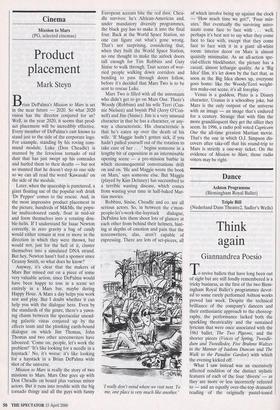Cinema
Mission to Mars (PG, selected cinemas)
Product placement
Mark Steyn
rian DePalma's Mission to Mars is set in the near future — 2020. So what 2020 vision has the director conjured for us? Well, in the year 2020, it seems that prod- uct placement will be incredibly effective. Every member of DePalma's cast knows to stand just to the side of the corporate logo. For example, standing by his roving com- mand module, Luke (Don Cheadle) is stunned by the ferocious tornado of red dust that has just swept up his comrades and hurled them to their deaths — but not so stunned that he doesn't step to one side so we can all read the word 'Kawasaki' on the side of the module.
Later, when the spaceship is punctured, a giant floating sac of the popular soft drink 'Dr Pepper' comes to the rescue. And, in the most impressive product placement in the picture, hundreds of M&Ms, the popu- lar multicoloured candy, float in mid-air and form themselves into a rotating dou- ble-helix. If I understand Sir Isaac Newton correctly, in zero gravity a bag of candy would either remain at rest or move in the direction in which they were thrown, but would not, just for the hell of it, cluster themselves into a simulated DNA strand. But hey, Newton hasn't had a sponsor since Granny Smith, so what does he know?
Anyway, it's clear that the makers of Mars Bar missed out on a piece of some very valuable action, since DePalma would have been happy to toss in a scene set entirely in a Mars bar, maybe during Happy Hour. A Mars a day helps you work rest and play. But I doubt whether it can help you with the dialogue here. Even by the standards of the genre, there's a yawn- ing chasm between the spectacular unend- ing galactic vistas conjured up by the effects team and the plonking earth-bound dialogue on which Jim Thomas, John Thomas and two other screenwriters have laboured: 'Come on, people, let's work the problem!' It's like looking for a needle in a haystack.' No, it's worse: it's like looking for a haystack in a Brian DePalma wide shot of the universe.
Mission to Mars is really the story of two missions to Mars. Mars One goes up with Don Cheadle on board plus various minor actors. But it runs into trouble with the big tornado thingy and all the guys with funny European accents bite the red dust. Chea- dle survives: he's African-American and, under mandatory diversity programmes, the black guy has to make it into the final four. Back at the World Space Station, no one can figure out what's gone wrong. That's not surprising, considering that, when they built the World Space Station, no one thought to make the airlock doors tall enough for Tim Robbins and Gary Sinise to walk through. Taut scenes of wor- ried people walking down corridors and bending to pass through doors follow, before it's decided that Mars Two is to be sent to rescue Luke.
Mars Two is filled with all the astronauts who didn't get to go on Mars One. There's Woody (Robbins) and his wife Tern (Con- nie Nielsen) and boyish Phil (Jerry O'Con- nell) and Jim (Sinise). Jim is a very unusual character in that he has a character, or any- way a characteristic. His characteristic is that he's eaten up over the death of his wife. 'If Maggie hadn't gotten sick, if you hadn't pulled yourself out of the rotation to take care of her . . . ' begins someone in a lengthy bit of exposition in an interminable opening scene — a pre-mission barbie in which inconsequential conversations drift on and on. 'He and Maggie wrote the book on Mars,' says someone else. But Maggie (played by Kim Delaney) has succumbed to a terrible wasting disease, which comes from wasting your time in half-baked Mar- tian movies.
Robbins, Sinise, Cheadle and co. are all serious actors. So, in between the c'mon- people-let's-work-the-haystack dialogue, DePalma lets them shoot lots of glances at each other from behind their helmets, hint- ing at depths of emotion and pain that the screenwriters, alas, aren't capable of expressing. There are lots of set-pieces, all 'I really don't mind where we visit next. To me, one place is very much like another ' of which involve being up against the clock — 'How much time we got?', 'Four min- utes.' But eventually the surviving astro- nauts come face to face with . well, perhaps it's best not to say what they come face to face with, except that they come face to face with it in a giant all-white room: interior decor on Mars is almost quaintly minimalist. As an all-action spe- cial-effects blockbuster, the picture has a casual, almost lethargic quality. As a 'Big Idea' film, it's let down by the fact that, as soon as the Big Idea shows up, everyone goes home: like the Woody/Terri weight- less make-out scene, it's all foreplay.
Venus is a goddess, Pluto is a Disney character, Uranus is a schoolboy joke, but Mars is the only outpost of the universe with an image — an image that's endured for a century. Strange that with film the more grandiloquent they get the sillier they seem. In 1996, a radio poll voted Capricorn One the all-time greatest Martian movie. That's the one in which O.J. Simpson dis- covers after take-off that his round-trip to Mars is strictly a one-way ticket. On the evidence of Mission to Mars, those radio voters may be right.


































































 Previous page
Previous page